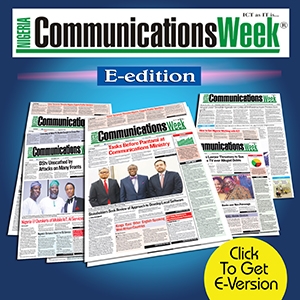Telecom
Tech Journalists Floor 5G Conspiracy Theory

With the debate on the health implication of the Fifth Generation (5G) technology, and the purported cabling of 5G fibre optic infrastructure in Nigeria, the Nigeria Information Technology Association (NITRA), an umbrella body for ICT Journalists in Nigeria, has laid out the facts concerning the effect of the technology to human health.
In a statement issued by Mr. Chike Onwuegbuchi, chairman NITRA explained that 5G is expected to connect people, things, data, applications, transport systems and cities in smart networked communication environments. The technology should transport a huge amount of data much faster, reliably connect an extremely large number of devices and process very high volumes of data with minimal delay.
“5G technologies are expected to support applications such as smart homes and buildings, smart cities, 3D video, work and play in the cloud, remote medical services, virtual and augmented reality, and massive machine-to-machine communications for industry automation. 3G and 4G networks currently face challenges in supporting these services,” he explained.

Mr. Onwuegbuchi however pointed out that despite the allegations by conspiracy theorists on the availability of 5G services in Nigeria, the cabling for 5G infrastructure, and the link between 5G and the current COVID-19 pandemic, Nigeria has not even released spectrum for 5G services to Mobile Network Operators (MNO), therefore it is technically impossible to run a 5G service in the country.
According to the NITRA Chairman, the Nigerian public should only source information from reliable authorities and experts on the issue, such as the International Telecommunications Union (ITU); the World Health Organisation (WHO), the nation’s telecommunication regulatory body, the Nigerian Communications Commission (NCC), and the supervisory Ministries, the Ministry of Communications and Digital Economy and the Ministry of Health.
Mr. Onwuegbuchi cited expert opinions on the matter, quoting WHO, which has categorically stated that viruses cannot travel on radio waves or mobile networks and that COVID-19 is a respiratory disease.
The technology was approved by the ITU.
ITU plays a leading role in managing the radio spectrum and developing globally applicable standards for IMT-2020. Its activities support the development and implementation of international regulations and standards to ensure that 5G networks are secure, interoperable, and that they operate without causing or receiving harmful interference to or from adjacent services.
Discussing alleged health risks from 5G, the WHO documented that “to date, and after much research performed, no adverse health effect has been causally linked with exposure to wireless technologies.”
However, WHO is further conducting a health risk assessment from exposure to radiofrequencies, covering the entire radiofrequency range, including 5G, to be published by 2022.
WHO will review scientific evidence related to potential health risks from 5G exposure as the new technology is deployed, and as more public health-related data become available.
WHO established the International Electromagnetic Fields (EMF) Project in 1996.
The project investigates the health impact of exposure to electric and magnetic fields in the frequency range 0-300 GHz and advises national authorities on EMF radiation protection.
On exposure levels, the WHO further establishes that currently, exposure from 5G infrastructures at around 3.5 GHz is similar to that from existing mobile phone base stations.
“With the use of multiple beams from 5G antennas, exposure could be more variable as a function of location of the users and their usage.
“Given that the 5G technology is currently at an early stage of deployment, the extent of any change in exposure to radiofrequency fields is still under investigation.”
A spokeswoman for the telecoms trade body GSMA said the new limits showed the safety of current and future technology. “Importantly, the health risk assessment is unchanged. The review found no established health risks to anyone, including children, using mobile phones or living near base stations,” she said.
A GSMA report reiterates that 5G adoption would grow as its benefits become visible. It points to the slow pace of awareness around the technology, suggesting that even increased knowledge about the usefulness need not translate into actions to upgrade or even intentions to do so.

Also, shedding more light on the issue, an independent international standards body, the International Commission on Non-Ionizing Radiation Protection (ICNIRP), which was set up in 1992 to assess the impact of electromagnetic and acoustic waves on people and the environment, said its current guidelines are mostly appropriate for the 5G era.
Medical health specialist have also lent their voices to the issue. Condemning the theories as “the worst kind of fake news”, National Medical Director of NHS England, Professor Steve Powis said: “I’m absolutely outraged, absolutely disgusted, that people would be taking action against the very infrastructure that we need to respond to this health emergency.”
Professor of Paediatrics at the University of Bristol, Professor Adam Finn, in his position said: “The internet connections these networks give us are one of the most important tools we are using to co-ordinate our response to the epidemic and efforts to do research to overcome it.”
Also, professor of microbial pathogenesis at the London School of Hygiene & Tropical Medicine, Prof Brendan Wren, said a connection between the phone masts and the virus would be “both a physical and biological impossibility.”
While applauding the people’s need for caution, Mr. Onwuegbuchi called on Nigerians to embrace new technologies as a means of improving the economy and joining global competitiveness.

He reiterated the motive behind the laying of fibre optic cables by MNOs, saying that the new cables are very necessary to improve the quality of service of telecommunication services, especially at the period when the networks are in increased usage.
He further explained that the timing was to enable the MNOs work feely without obstructing traffic or easy movement of people.
He stressed that the laid fibre optic cables were for 3G and 4G services and cannot be used for 5G service yet because the operators have not been issued spectrum for the service.
While pledging support for the NCC and the Ministry of Communications and Digital Economy in their bid to position Nigeria among the Digitally Innovative nations, NITRA urged Nigerians to look beyond the rumours surrounding the 5G technology and support the federal government if, and when they eventually choose to adopt the technology.
“Just like the NCC and the Ministry said, before the country will adopt 5G technology, they will consult all stakeholders, and research further into the implications of the technology,” Mr. Onwuegbuchi encouraged.
The Nigeria Information Technology Reporters Association (NITRA) is the umbrella association for information and communication technology reporters in Nigeria.
Telecom
Airtel Africa Grew Customer Base to 169m as Q1 Revenue Hits $1.4 Billion

Airtel Africa has grown its customer base by 9.0% to 169.4 million, with data customers increasing 17.4% to 75.6 million with focus on bridging the digital divide across her markets continues. According to the telecommunications operator’s financial results for the quarter ended June 30, 2025, which demonstrated strong growth across key metrics and a continued focus on expanding its services across its 14 African markets.

The operator reported a significant increase in revenue, reaching $1,415 million. This represents a 24.9% growth in constant currency and a 22.4% increase in reported currency, indicating a more stable macroeconomic environment in its operating regions and effective tariff adjustments, particularly in Nigeria.
The growth was broadly driven, with mobile services revenue increasing by 23.8% in constant currency. Data revenue showed exceptional performance, surging by 38.1%, while voice revenue grew by 13.9%. Mobile money services continued their strong upward trajectory, recording a 30.3% growth in constant currency. This was supported by accelerated growth in Francophone Africa (16.4% in constant currency) and continued strong performance in East Africa (20.3% in constant currency).
Airtel Africa’s profitability also saw a substantial uplift. EBITDA grew by 29.8% in reported currency to $679 million, with EBITDA margins expanding to 48.0% from 45.3% in the prior period. This margin expansion is attributed to sustained operating momentum, more stable fuel prices, and the ongoing benefits from cost efficiency programs.
Profit after tax saw a remarkable improvement, rising to $156 million compared to $31 million in the prior period. Basic Earnings Per Share (EPS) stood at 3.4 cents, a significant increase from 0.2 cents in the previous year, primarily reflecting higher operating profit in the current period and the absence of large derivative and foreign exchange losses that impacted the prior period.
Operational highlights further underscored the company’s growth. Airtel Africa’s total customer base expanded by 9.0% to 169.4 million. Data customers increased by 17.4% to 75.6 million, as the company intensified its efforts to bridge the digital divide. Mobile money customer base also grew by 16.1% to 45.8 million, with transaction value increasing by 28.7% in constant currency.
The company’s strategic focus on enhancing customer experience is supported by ongoing network investments. Over 2,300 new sites were rolled out, bringing the total to 37,579 sites, and the fiber network was expanded by 2,700 km, now exceeding 79,600 km. This investment has boosted data capacity across the region, with 4G population coverage reaching 74.7%, an increase of 3.4% year-on-year.
Airtel Africa continued its debt localization program, with almost 95% of its operating company debt (excluding lease liabilities) now in local currency, up from 86% a year ago, reducing foreign currency debt exposure. The company also confirmed it has returned $16.9 million to shareholders through its ongoing share buyback program as of June 30, 2025.
Sunil Taldar, chief executive officer, said: “We are very pleased with the strong growth in our operating and financial performance in the first quarter. The strength of this performance, and the scale of the growth we achieved, reflects the sustained demand for our services and the strength of our business model to meet these demands. Operationally, the acceleration in customer base growth to 9%, and 17.4% growth in our data customers to 75.6m reflects the strong on-ground execution with a relentless focus on digitisation and the simplification of the customer experience.”
Telecom
NITRA-ALTON CNII & Sustainability Conference Rescheduled for August 7 in Lagos

The 2025 edition of the Critical National Information Infrastructure (CNII) & Sustainability Conference has been rescheduled to hold on August 7, 2025, at CitiHeight Hotel, Ikeja, Lagos, following a shift from its earlier date of July 30.

The adjustment was made to accommodate a nationwide telecom stakeholders’ meeting convened by the Nigerian Communications Commission (NCC).
The CNII Conference, jointly organised by the Nigeria Information Technology Reporters Association (NITRA) and Association of Licensed Telecommunications Operators of Nigeria (ALTON), seeks to address the implementation and awareness gaps surrounding the CNII Order, signed into law by the Federal Government in August 2024.
The law designates telecom infrastructure as Critical National Information Infrastructure, positioning it as a strategic asset vital to Nigeria’s economic and security framework. Industry groups including the Association of Telecommunications Companies of Nigeria (ATCON) have thrown their weight behind the initiative.
Speaking on the new date, NITRA Chairman, Mr. Chike Onwuegbuchi, emphasised that the Act, though laudable, requires industry-wide collaboration and clear implementation strategy for tangible impact.
“The mere proclamation of CNII as an Act does not guarantee infrastructure safety. Stakeholders must address operational and standardisation gaps to make the law work,” he said.
ALTON Chairman, Engr. Gbenga Adebayo, also highlighted the need for regular maintenance and technology upgrades to curb vandalism and ensure infrastructure security.
Focus Areas of the Conference Include:
- Implementation mechanisms for the CNII Act.
- Stakeholders’ roles at federal, state, and industry levels.
- Security enforcement and public education.
- Infrastructure protection and sustainability.
- Collaboration and compliance across telecom companies.
Expected attendees include the Minister of Communications, Innovation and Digital Economy, regulators, service providers, security agencies, and key players in public and private sectors.
The event is themed “Industry Sustainability And CNII Conference 2025 – Way Forward”, with panel discussions aimed at creating a unified approach to safeguarding Nigeria’s telecom infrastructure under the CNII provisions.
Telecom
Telcos: How and Why Network Services have Been Poor

Telecommunications operators (telcos) in Nigeria have explained that the recent poor quality of network services experienced across the country is largely due to the widespread vandalism and theft of critical telecom infrastructure, not a failure on their part.

Gbenga Adebayo, chairman, ALTON
The operators, under the aegis of the Association of Licensed Telecommunications Operators of Nigeria (ALTON), said their efforts to improve services through massive investments and network upgrades are being undermined by unchecked sabotage and the lack of sufficient protection from security agencies.
They warned that unless urgent action is taken, the situation could worsen in the coming days, affecting not just voice and data services but also key sectors like banking, education, healthcare, and national security that rely on stable telecommunications.
A top official from one of the major mobile network providers, who spoke anonymously, said operators had kept their promise to enhance service quality following a recent tariff adjustment approved by the Nigerian Communications Commission (NCC), but their efforts are being eroded by relentless vandalism.
“At the wake of the marginal price adjustment that the NCC approved for the sector, we promised to optimize our networks to give Nigerians a very robust service,” the official said
“But what we are seeing after making such huge investments is that vandals are carting away our facilities without a challenge and selling them in open markets. That’s why services are a bit poor and that is why if nothing is done urgently, it will get worse.
In a statement jointly signed by Gbenga Adebayo, chairman, and Damian Udeh, publicity secretary, ALTON expressed deep concern over the scale and spread of infrastructure sabotage across the country.
“Since the Federal Government’s decisive interventions earlier this year to support industry sustainability, our members have committed unprecedented levels of investment in network optimization and capacity upgrades,” the statement read.
“New systems are being deployed, transmission equipment modernized, power systems overhauled, and thousands of kilometers of fiber optic networks currently being laid and expanded. Our industry has not seen this scale of investment in recent years. We are working round the clock to improve the quality of service nationwide and we cannot afford these setbacks.”
Between May and July 2025, the association recorded numerous cases of vandalism at telecom sites across Rivers, Ogun, Osun, Imo, Kogi, Ekiti, Lagos, Abuja, and several other states, resulting in widespread outages and degraded service quality for millions of subscribers.
Stolen assets include power cables, rectifiers, fiber optic and feeder cables, diesel generators, batteries, and solar panels, all vital for maintaining consistent network availability.
“These are not mere materials, but the backbone of our digital economy, security systems, and national communications grid,” ALTON said. “We are alarmed at the frequency, intensity, and geographical spread of these incidents.”
Telcos on poor network services also raised alarm over a thriving black market for stolen telecom equipment.
“Batteries are being resold for household and office inverters, solar panels are stripped from sites and traded to unsuspecting buyers, while diesel meant for powering telecom base stations is routinely siphoned and sold.”
In addition to vandalism, ALTON cited damage caused by road construction and civil engineering projects, which frequently destroy underground fiber optic cables, leading to unplanned service disruptions and financial losses.
The group has called on key security stakeholders, including the Office of the National Security Adviser (ONSA), the Inspector General of Police, the DSS, and the NSCDC to urgently step in and protect telecom assets nationwide.

 E-Financial2 days ago
E-Financial2 days agoKuda Unveils New Wallet for Multiple Currencies

 Telecom2 days ago
Telecom2 days agoTelcos Resume SIM Card Sales after 2-Week Halt

 Telecom2 days ago
Telecom2 days agoNigeria, Others Achieve 84% Adult Mobile Phones Penetration

 E-Business2 days ago
E-Business2 days agoHow AI Alert by Airtel is Transforming Mobile Security in Africa

 E-Business2 days ago
E-Business2 days agoNITDA, API Partner Against Harmful Online Content

 Telecom1 day ago
Telecom1 day agoTelcos: How and Why Network Services have Been Poor

 News2 days ago
News2 days agoHorn of Africa Leaders Seek Enhanced Digital Integration for Increased Regional Growth

 Telecom2 days ago
Telecom2 days agoSophos Secures Leadership Spot in 2025 Gartner Magic Quadrant for Endpoint Protection



























